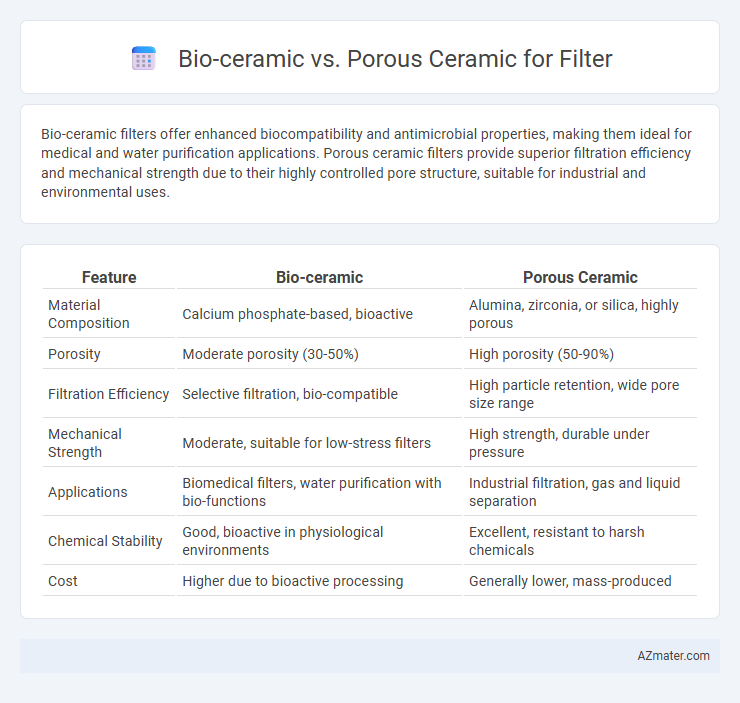Bio-ceramic filters offer enhanced biocompatibility and antimicrobial properties, making them ideal for medical and water purification applications. Porous ceramic filters provide superior filtration efficiency and mechanical strength due to their highly controlled pore structure, suitable for industrial and environmental uses.
Table of Comparison
| Feature | Bio-ceramic | Porous Ceramic |
|---|---|---|
| Material Composition | Calcium phosphate-based, bioactive | Alumina, zirconia, or silica, highly porous |
| Porosity | Moderate porosity (30-50%) | High porosity (50-90%) |
| Filtration Efficiency | Selective filtration, bio-compatible | High particle retention, wide pore size range |
| Mechanical Strength | Moderate, suitable for low-stress filters | High strength, durable under pressure |
| Applications | Biomedical filters, water purification with bio-functions | Industrial filtration, gas and liquid separation |
| Chemical Stability | Good, bioactive in physiological environments | Excellent, resistant to harsh chemicals |
| Cost | Higher due to bioactive processing | Generally lower, mass-produced |
Understanding Bio-Ceramic and Porous Ceramic Filters
Bio-ceramic filters are engineered from biologically compatible materials that facilitate natural filtration processes by promoting microbial growth and enhancing water quality. Porous ceramic filters feature a highly permeable microstructure that traps contaminants through physical adsorption and mechanical sieving, making them effective for removing bacteria and suspended particles. Both bio-ceramic and porous ceramic filters offer durable, eco-friendly solutions but differ in their filtration mechanisms, with bio-ceramics emphasizing biological activity and porous ceramics relying on physical filtration.
Composition and Structure Differences
Bio-ceramic filters are typically composed of biocompatible materials like hydroxyapatite and zirconia, designed to promote bioactivity and cellular integration, whereas porous ceramics primarily consist of alumina or silicon carbide, engineered for mechanical strength and filtration efficiency. The structure of bio-ceramic filters is often characterized by interconnected porosity with controlled pore sizes to facilitate fluid flow and biological interaction, while porous ceramic filters exhibit a more uniform and rigid pore network optimized for particulate retention and durability. These compositional and structural differences directly influence their filtration applications, with bio-ceramics prioritizing biocompatibility and porous ceramics emphasizing filtration precision and structural stability.
Filtration Efficiency Compared
Bio-ceramic filters exhibit higher filtration efficiency due to their enhanced antimicrobial properties and uniform pore distribution, effectively removing bacteria, viruses, and organic contaminants. Porous ceramic filters, while also efficient in particulate removal, tend to have larger and less consistent pore sizes, resulting in moderate filtration performance primarily targeting sediment and larger particles. The superior microporosity and bioactive surface of bio-ceramics enable prolonged filter lifespan and improved contaminant adsorption compared to conventional porous ceramics.
Mechanical Strength and Durability
Bio-ceramic filters exhibit superior mechanical strength and durability compared to porous ceramics due to their dense microstructure and high resistance to wear and corrosion. Porous ceramics, while offering excellent filtration efficiency, tend to have lower mechanical strength because of their high porosity, making them more susceptible to fractures under mechanical stress. The enhanced durability of bio-ceramics ensures longer service life in demanding filtration applications, reducing replacement frequency and maintenance costs.
Flow Rate and Permeability Analysis
Bio-ceramic filters exhibit higher flow rates and superior permeability compared to porous ceramic due to their optimized microstructure that enhances fluid dynamics and reduces clogging. Permeability analysis reveals bio-ceramics maintain stable pore channels, promoting efficient passage of contaminants while preserving filtration speed. Porous ceramics, with their irregular and smaller pores, often result in decreased flow rate and reduced permeability, limiting their performance in high-demand filtration systems.
Anti-bacterial and Anti-fouling Properties
Bio-ceramic filters exhibit superior anti-bacterial properties due to their inherent ion-release capabilities that inhibit microbial growth, enhancing water purification effectiveness. Porous ceramic filters rely on their microstructure to physically trap bacteria and particulates, but may be more prone to biofilm formation, reducing anti-fouling efficiency over time. The integration of bio-ceramic materials offers enhanced durability in maintaining anti-fouling surfaces compared to traditional porous ceramics, making them optimal for long-term filtration applications.
Applications in Water and Air Filtration
Bio-ceramic and porous ceramic filters excel in water and air filtration by leveraging their unique structural properties. Bio-ceramics offer enhanced antimicrobial activity and chemical stability, making them ideal for removing pathogens and toxic substances in water treatment and air purification systems. Porous ceramics provide high permeability and mechanical strength, enabling efficient particulate capture and long-term durability in industrial and residential filtration applications.
Environmental Impact and Sustainability
Bio-ceramic filters, derived from natural materials like clay and minerals, offer superior biodegradability and reduced environmental footprint compared to porous ceramic filters made from synthetic or heavily processed materials. Porous ceramics often require high-energy manufacturing processes and non-renewable raw materials, resulting in greater carbon emissions and resource depletion. Selecting bio-ceramic filters promotes sustainability by minimizing ecological harm and supporting circular economy principles through eco-friendly sourcing and disposal.
Cost-Effectiveness and Longevity
Bio-ceramic filters generally offer higher cost-effectiveness due to their enhanced durability and resistance to corrosive environments, reducing replacement frequency compared to porous ceramic filters. Porous ceramic filters, while initially cheaper, often require more frequent replacement because their microstructure is susceptible to clogging and degradation over time. The longer lifespan of bio-ceramics in filtration systems translates to lower maintenance expenses and better overall value in industrial and water purification applications.
Choosing the Right Ceramic Filter for Your Needs
Bio-ceramic filters offer enhanced biocompatibility and antimicrobial properties, making them ideal for medical and water purification applications where hygiene is critical. Porous ceramic filters provide superior mechanical strength and high filtration efficiency, suited for industrial processes requiring durability and fine particle removal. Selecting the right ceramic filter depends on specific needs such as filtration precision, chemical resistance, and application environment.

Infographic: Bio-ceramic vs Porous Ceramic for Filter
 azmater.com
azmater.com